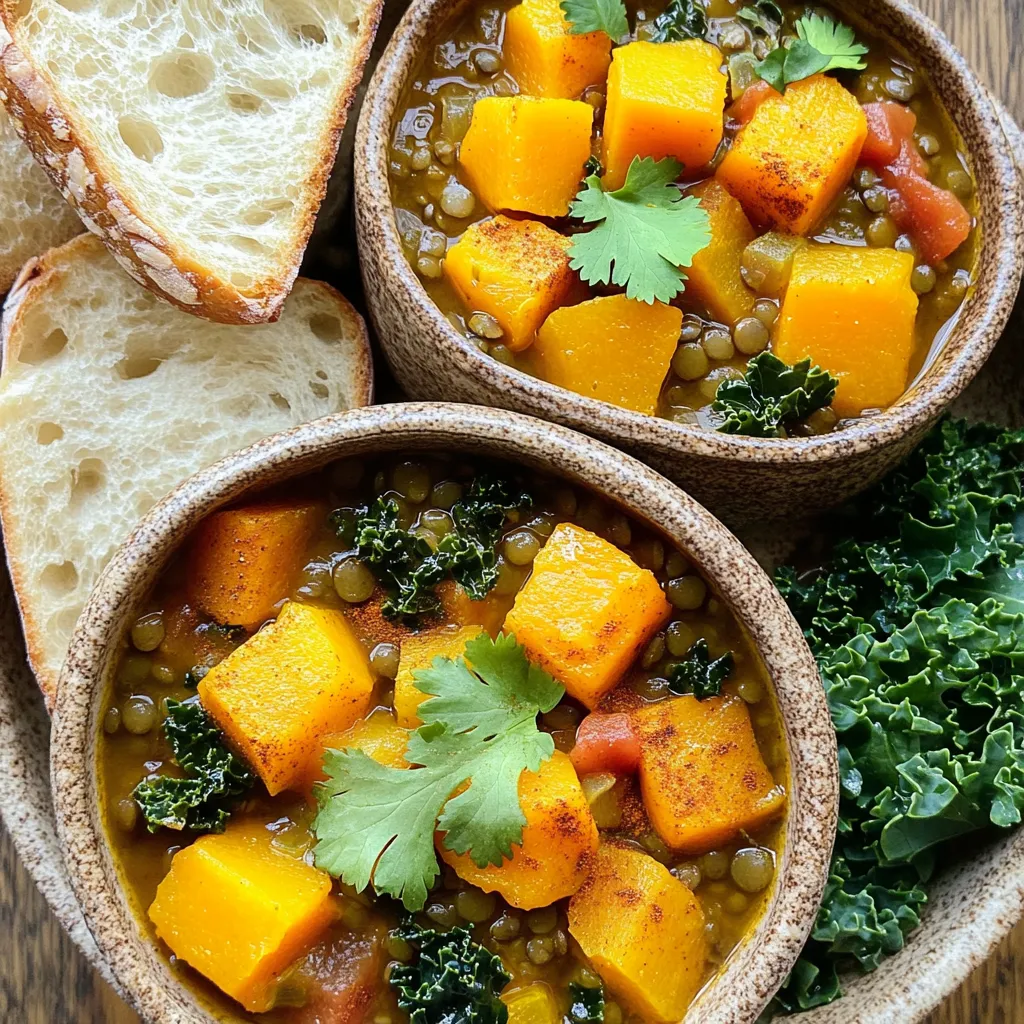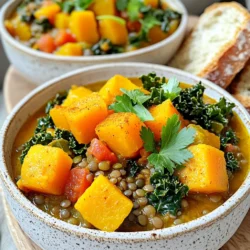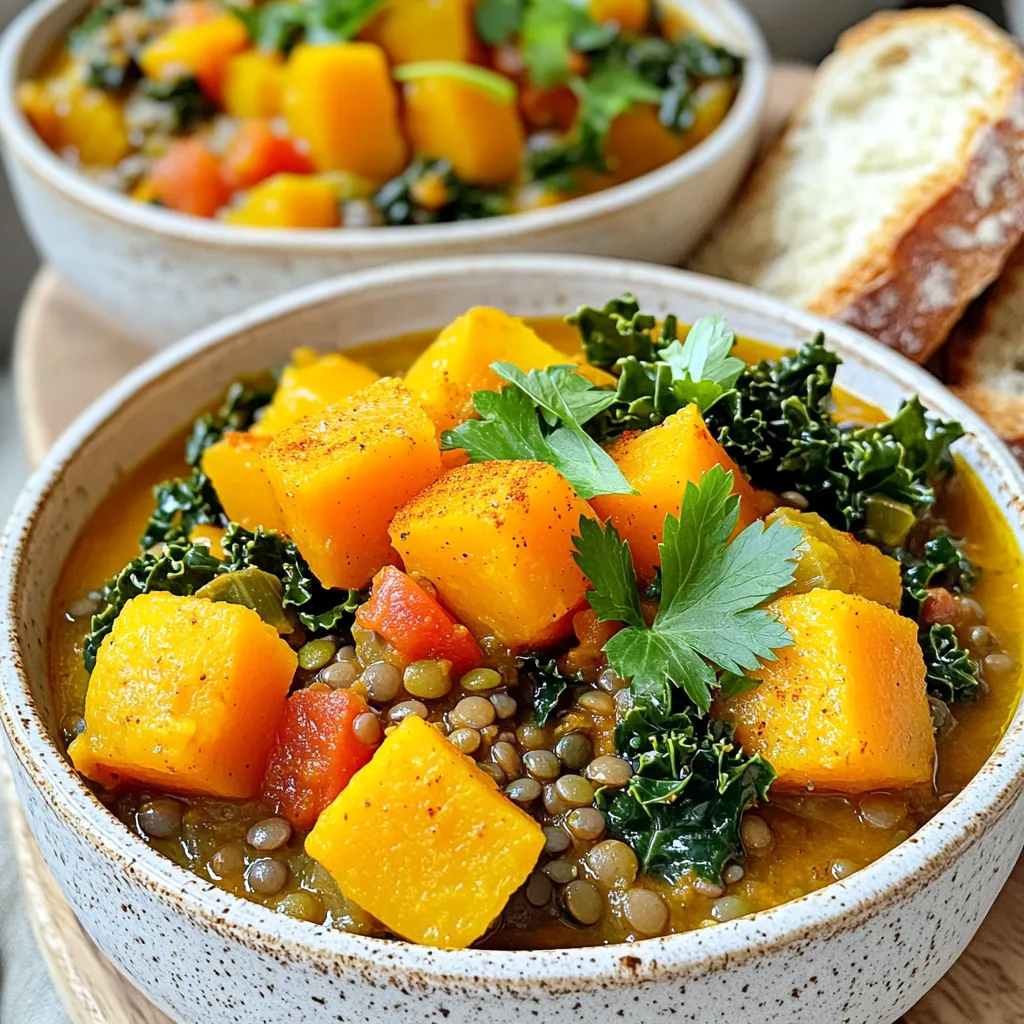Looking for a cozy meal that’s easy to make and packed with flavor? My Slow Cooker Butternut Squash and Lentil Stew Delight is just what you need! This stew combines healthy veggies and lentils for a dish that’s warm and filling. Whether you’re a busy professional or a parent on the go, this recipe fits into your life. Let’s dive into the wholesome ingredients and simple steps that will make your dinner a hit!
Ingredients
Complete List of Ingredients
- 1 medium butternut squash, peeled and cubed
- 1 cup green or brown lentils, rinsed
- 1 large onion, chopped
- 3 cloves garlic, minced
- 2 carrots, diced
- 2 celery stalks, diced
- 1 can (14 oz) diced tomatoes
- 4 cups vegetable broth
- 2 teaspoons ground cumin
- 1 teaspoon smoked paprika
- 1 teaspoon turmeric
- 1 teaspoon dried thyme
- Salt and pepper to taste
- 2 cups kale, chopped
- 2 tablespoons olive oil
- Fresh cilantro or parsley for garnish
Substitutions for Fresh Ingredients
You can swap the butternut squash for sweet potatoes if you want. Zucchini also works well in place of celery. Use red lentils if you prefer a softer texture. If you don’t have fresh garlic, garlic powder is a quick fix.
Dietary Considerations (Vegan, Gluten-Free)
This stew is fully vegan, so it fits well for plant-based diets. It is gluten-free since all ingredients are free of gluten. Make sure to check your vegetable broth to confirm it is gluten-free. This recipe is great for anyone seeking healthy meals.
Step-by-Step Instructions
Preparing the Vegetables
Begin with a clean workspace. Peel the butternut squash and cut it into cubes. Aim for bite-sized pieces. Next, chop the onion and mince the garlic. Dice the carrots and celery too. Rinse the lentils under cold water to remove any dust. Gather all these fresh veggies and lentils in one bowl. This makes it easier to add them to the slow cooker.
Cooking Times for Slow Cooker Settings
Now, it’s time to set up your slow cooker. Add all the prepared ingredients into the pot. Pour in the diced tomatoes with their juice and the vegetable broth. Sprinkle in the spices: ground cumin, smoked paprika, turmeric, and dried thyme. Add salt and pepper to taste. Drizzle the olive oil over everything. Stir gently to mix well.
Cover the slow cooker and choose your cooking time. For low heat, set it for 6 to 8 hours. If you’re short on time, you can set it to high for 3 to 4 hours. This is the magic of slow cooking. The longer it cooks, the better the flavors blend.
Final Touch with Kale Addition
About 30 minutes before you serve the stew, it’s time to add the kale. Chop it into smaller pieces and stir it into the pot. The kale adds a nice color and a healthy boost. Let it cook for the remaining time. When it’s ready, taste the stew. Adjust the seasoning if needed. Serve it hot and enjoy!
Tips & Tricks
How to Perfect the Texture of the Stew
To get the right texture, start with fresh butternut squash. Make sure it is peeled and cubed evenly. This helps it cook well. Use green or brown lentils, as they hold their shape better. Avoid red lentils, as they turn mushy. Let the stew cook slowly. This way, all the flavors mix and the veggies get tender.
Flavor Enhancements and Seasoning Adjustments
For added flavor, try using fresh herbs. Fresh thyme or cilantro can really boost the taste. You can also add a splash of lemon juice before serving. This brightens the dish. If you like more heat, add a pinch of red pepper flakes. Adjust salt and pepper to your liking. Always taste the stew before serving to make sure it’s just right.
Best Practices for Slow Cooking
When slow cooking, layering ingredients matters. Start with the denser items like squash and lentils at the bottom. This lets them soak up all the flavors. Don’t peek too often, as this releases heat. Set your slow cooker to low for a longer cook time. This helps the flavors develop fully. Remember to add kale near the end to keep it vibrant and fresh.

Variations
Adding Protein (Beans, Chicken, etc.)
You can easily boost the protein in your Slow Cooker Butternut Squash and Lentil Stew. Try adding beans or chicken. For beans, black beans or chickpeas work well. Just rinse and drain them before adding. If you prefer chicken, use boneless, skinless thighs. Chop them into bite-sized pieces. Add the chicken at the start of cooking for tender results.
Spice Level Modifications
Want to spice things up? Adjust the heat in your stew. Add cayenne pepper for a kick. Start with a small amount, about 1/4 teaspoon. You can also mix in diced jalapeños for fresh spice. If you prefer mild flavors, reduce the smoked paprika. This way, you can tailor the stew to your taste.
Alternative Vegetable Combinations
Feel free to change up the veggies in your stew. Sweet potatoes or turnips can replace butternut squash. They add a nice twist and flavor. You can also include bell peppers or zucchini for extra color. Just be mindful of cooking times. Add quicker-cooking veggies later, about halfway through the stew’s cooking time. This keeps them from getting too soft.
Storage Info
How to Store Leftovers
To store your leftover stew, let it cool to room temperature. Then, scoop it into an airtight container. This keeps the stew fresh and tasty. You can store it in the fridge for up to five days. Make sure to label the container with the date. This way, you won’t forget when you made it.
Freezing and Reheating Instructions
If you want to keep the stew longer, freezing is a great option. Pour the cooled stew into freezer-safe bags or containers. Leave some space at the top for expansion. You can freeze it for up to three months. When you are ready to eat, thaw it overnight in the fridge. Reheat it on the stove or in the microwave until it’s hot. Stir well to ensure even heating.
Shelf Life of the Stew
The stew lasts about five days in the fridge. If you freeze it, it can last up to three months. After that, the stew may lose its flavor and texture. Always check for any off smells or changes in color before eating leftover stew. If it seems off, it’s best to toss it out.
FAQs
Can I use a different type of squash?
Yes, you can use other squashes. Acorn or pumpkin works well too. Each type adds a unique taste. Choose one that you like best. If you pick a sweeter squash, adjust the spices to balance the flavor. Experiment and find your favorite!
How do I fix an overcooked stew?
If your stew is too soft, you can try a few things. First, add more broth or water to thin it out. This will help balance the texture. If it’s too mushy, try stirring in some fresh, chopped vegetables. They will add crunch and freshness. Serve it over rice or a grain for some extra texture.
What sides pair well with this stew?
This stew pairs nicely with crusty bread or rice. You can also serve it with a simple salad. A green salad with a light dressing works great. It adds freshness and contrast to the warm stew. Consider cornbread for a hearty touch. Each option complements the flavors of the stew well.
This blog post covered all key points about making a delicious stew. We discussed the best ingredients and how to swap fresh ones. Dietary needs like vegan and gluten-free options were noted too.
I shared step-by-step cooking tips, including prep, timing, and adding kale. You learned about texture, flavor, and effective slow cooking. We explored fun variations, storage, and answered common questions.
Now, you’re ready to whip up a hearty stew. Enjoy the flavors and creativity of cooking your own way!


